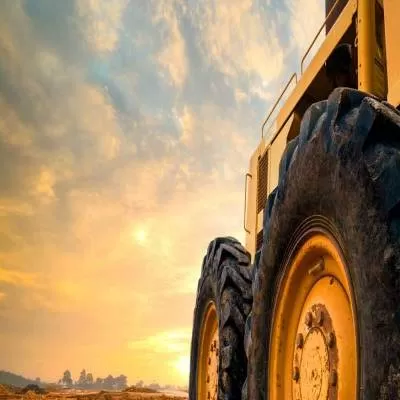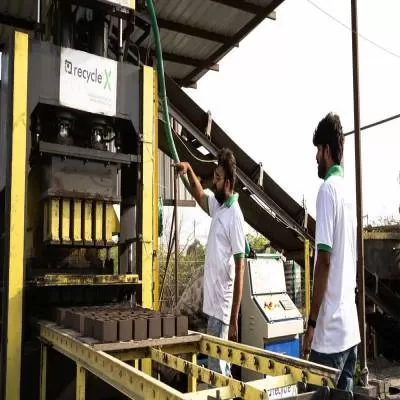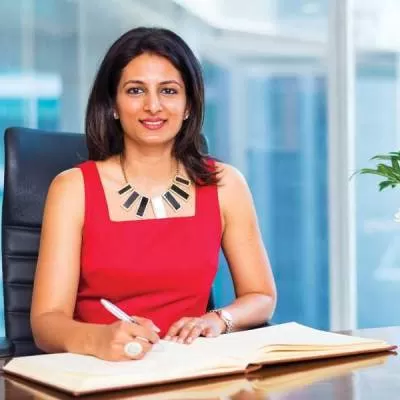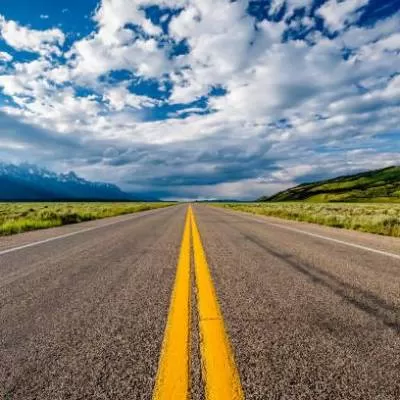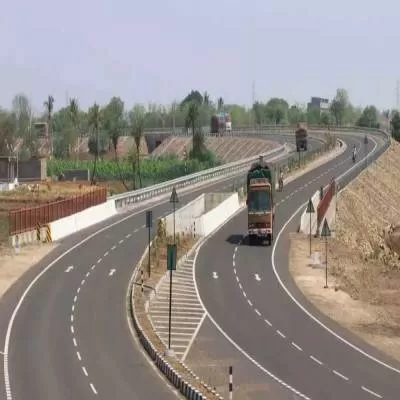- Home
- Infrastructure Transport
- ROADS & HIGHWAYS
- Dream Weaver
Dream Weaver
In the fourth of a series of interviews with prominent engineers, Janaki Krishnamoorthi meets Kamal Lalla, City Engineer, Thane Municipal Corporation.
Kamal Lalla, who has prepared a vision document for Thane, also has several dream plans for the city. Even though the city engineer of Thane Municipal Corporation (TMC) is aware that many of them may not be realised during his tenure — or even later — it doesn’t deter him from striving to make them reality. Like James Allen, he believes that “The key to happiness is having dreams; the key to success is making your dreams come true.”
“Hundreds of ideas keep popping up in my mind,” shares Lalla. “I know it will be difficult to implement most of them in our present environment but that does not disillusion me. I keep trying in the hope that at least some will see the light of the day. And it is happening, slowly but surely.” More so, since he joined TMC, his recommendations for roads and pavements, like the use of ultra thin white topping instead of cement concrete, interlocking cement concrete blocks and semi-rigid pavements for coastal areas, have been implemented. So have his plans for lake beautification and flooding control in Thane. He also succeeded in introducing proper systems and streamlining operations at TMC despite opposition from certain quarters. “These systems introduced checks and balances and naturally there was opposition to them,” he says with candour. “But I was able to implement them. Fortunately, all my commissioners and most politicians have been supportive of my efforts.” Lalla was later commended by TMC for improving performances all around.
Lalla has also successfully executed two major projects of TMC: the Station Area Traffic Improvement Scheme (SATIS) at Thane station and a 110 mld water supply project. In his long list of projects to shepherd, two very close to his heart are the Thane creek development and the Ring Rail. Approved by TMC’s general body, both are now awaiting the state government’s nod. “Through the creek development programme we can resolve several issues like creek pollution, city flooding and simultaneously create entertainment parks, tourist centres and water transport,’ he reveals. “It is an exhaustive and complex project.” As is the Ring Rail envisaged along a 40-m corridor with 10 stations that is likely to be implemented through BOT. To make the project viable, TMC is planning to grant additional FSI on the stations as an incentive to the BOT operator. “We are also looking to develop high-density zones on either side of the corridor that, among other things, will have premium housing projects. The income generated will not only meet the cost of the Ring Rail but take care of all the infrastructure schemes planned for Thane.”
Having handled a wide spectrum of projects — housing, flyovers, roads, ports, water supply, sewerage, storm water drains — and many more to go, this 54- year-old engineer concedes his vocation is a demanding and stressful one. But the pleasure he derives from his job makes it all worthwhile, insists Lalla, who lists yoga, meditation, travel and trekking as his stress busters. Getting back to business, he shares his views on his profession and the industry with CW....
The gap
We lag far behind in infrastructure compared to other countries. Roads, railways, airports, ports... everything needs qualitative changes. With our wonderful coastline we can develop inland water transport that can decongest our city roads. Water transport can help move inland cargo, largely freeing our city roads of trucks and containers. We should also develop satellite towns around major cities with good connectivity; this will prevent the population from migrating to cities. We can develop five satellite towns around Thane alone.
Paucity of civil engineers
With lucrative opportunities in IT and ITES sectors, there have been few takers for civil engineering for over a decade now. As a result we are running short of engineers. If we advertise for 100 posts we do not get even 100 candidates! With the Indian government planning to invest huge amounts in infrastructure, the situation will only get worse. If we do not address the issue now, we will have no choice but to employ expat engineers from Japan, Korea, China, etc. The construction industry must come forward to improve the salary structure of civil engineers, which is the major reason behind the disinterest in the profession. Today, a fresh civil engineering graduate is being paid a salary ranging between Rs 5,000 and Rs 10,000 whereas in the IT sector the starting salary is around Rs 40,000. So why would anybody opt for civil engineering that also involves working at site in unfavourable conditions? It is not that the industry is unaware of the shortage or the issues involved but nobody is taking the lead to address them.
Why our roads and bridges cave in
As per regulations, every road is designed to carry a certain permissible load. But in reality there is always overloading, leading to roads giving way. Alternately, we must design roads taking into consideration the actual load they will carry. This will, of course, increase costs. Second, a road under construction or repair should be totally closed till the work is complete. But that does not happen and citizens use it while the work is underway, which also affects its quality. Poor material selection and insufficient time for construction also play a vital role. If all these points are taken into consideration we will have quality roads. In bridges, it is generally expansion joints that give way owing to poor workmanship. In fact, inferior workmanship and lack of meticulous supervision are the major reasons behind many project failures. An engineer in charge of a project must be there to oversee each and every important activity. For instance, in road construction he should oversee each and every layer being set, when rolling is carried out and when watering is being done, which is rarely the case. He will leave it to the contractor, who in turn will leave it to the subcontractor and then it goes down to the foreman, workman, etc. Finally there is nobody supervising the work. When Japanese, Chinese or Korean engineers are willing to work at site why are our engineers disinclined? The same engineers and contractors work hard when employed by foreign companies handling projects in India. When foreigners can use our people and get good quality work why are we unable to do it? It is because they are motivated with handsome salaries and good working conditions. We need to take quick action to ensure quality in our projects.
Accolades:
• National Award for Excellence for design of multi transport solution. (SATIS) in Thane (2009)
• Sant Gadge Baba award for Swachata Abhiyan (2009).
• Outstanding Engineer Award from TMC (2009).
• Shahid Mangal Pandey award for Best Engineer (2010).
• Vasundhara award from Maharashtra Government for environment measures taken in Thane (2010).
• PV Patki award from Indian Water Works Association for best article on integrated approach to water supply and sewerage (2010).
Track record: Kamal Daryanomal Lalla
• BE (Civil) from Bombay University (1981).
• Joined City & Industrial Development Corporation (CIDCO) as Junior Engineer and handled housing and infrastructure projects (1981-1986).
• Joined Jawaharlal Nehru Port Trust (JNPT) as Manager, Port Planning and Development, and handled port construction (1986-2001).
• Promoted as Chief Engineer of Mormugao Port but opted to join Thane Municipal Corporation as City Engineer (2001 till date). Responsible for Thane city’s planning and development including water supply system, sewerage scheme, transport infrastructure, slum rehabilitation, etc.
• Representative of Government of India for water supply issue at the South Asia Water Utility Network (Asian Development Bank).
• Member of Indian Concrete Institute, Indian Water Works Association and Institute of Engineers.
Challenging projects:
Project: Station Area Traffic Improvement Scheme (SATIS )
Location: Thane Railway station
Period: 2007-2009
Cost: Rs 31 crore
Implemented under: Jawaharlal Nehru National Urban Renewal Mission (JNNURM)
Features:
1. Dispersal of traffic through three modes: low-level deck with bus stops, exclusive flyover for buses with two ramps connecting lower deck and two skywalks for pedestrian commuters.
2. Concourse area connecting railway bridges,
skywalks and low level deck.
3. Area below low-level deck with separate pick-up points for auto-rickshaws, taxis, emergency vehicles, private vehicles, etc.
Innovation: Girder casting using steam curing for speedy construction.
Challenges: Overcoming several initial hiccups including objections from auto-rickshaw drivers, illegal hawkers, a PIL against SATIS (which was dismissed by Bombay High Court) and obtaining sanctions from Central Railway. The most difficult issue was shifting the Ambedkar statue from Ambedkar junction, which held up the last pile for six months. Discussions were held for four months with members of the Republican Party of India and everybody even remotely connected with it. “Giving a patient hearing to everybody, documenting every word discussed and agreed, and maintaining transparency throughout helped us sort it out,” recalls Lalla. The statue was finally moved to the present site and TMC has agreed to replace the existing bust with an 8-ft life size statue. “Undertaking such a massive project amid a chaotic, crowded area with heavy vehicular and pedestrian movement was in itself a big challenge,” he asserts. “After completing it, I feel I can now take on 100 more SATIS!”
Recognition: Won Award for Excellence from Ministry of Urban Development, Government of India.
Project: 110 mld water supply scheme from Pise Head Works for Thane city
Location: Thane
Period: 2007-2009
Cost: Rs 95 crore
Implemented under: JNNURM
Features: Totally automated system with SCADA (supervisory control and data acquisition) enabling centralised monitoring and control of water supply, on-line water and energy audit, programmed purification controls, detection of distribution losses through alarms, etc. Several energy-saving measures undertaken, resulting in saving of around Rs 2 crore per annum, water conservation of 7 to 8 mld through recirculation. “We did an energy audit and found we were pumping water unnecessarily to a higher level at two points and wasting energy,” shares Lalla. “We brought down the level of old bridge pressure tanks by 10 m, which also involved modifications in the engineering network like redesigning existing pumps and pumping main. This modification alone will help us recover the project cost in 25 years.”
Challenges: Implementing the new project while running the old system in parallel. “We had to keep the old water supply lines operational and transfer them to the new ones as and when the new ones were ready, which was very challenging,” says Lalla.
In the fourth of a series of interviews with prominent engineers, Janaki Krishnamoorthi meets Kamal Lalla, City Engineer, Thane Municipal Corporation. Kamal Lalla, who has prepared a vision document for Thane, also has several dream plans for the city. Even though the city engineer of Thane Municipal Corporation (TMC) is aware that many of them may not be realised during his tenure — or even later — it doesn’t deter him from striving to make them reality. Like James Allen, he believes that “The key to happiness is having dreams; the key to success is making your dreams come true.” “Hundreds of ideas keep popping up in my mind,” shares Lalla. “I know it will be difficult to implement most of them in our present environment but that does not disillusion me. I keep trying in the hope that at least some will see the light of the day. And it is happening, slowly but surely.” More so, since he joined TMC, his recommendations for roads and pavements, like the use of ultra thin white topping instead of cement concrete, interlocking cement concrete blocks and semi-rigid pavements for coastal areas, have been implemented. So have his plans for lake beautification and flooding control in Thane. He also succeeded in introducing proper systems and streamlining operations at TMC despite opposition from certain quarters. “These systems introduced checks and balances and naturally there was opposition to them,” he says with candour. “But I was able to implement them. Fortunately, all my commissioners and most politicians have been supportive of my efforts.” Lalla was later commended by TMC for improving performances all around. Lalla has also successfully executed two major projects of TMC: the Station Area Traffic Improvement Scheme (SATIS) at Thane station and a 110 mld water supply project. In his long list of projects to shepherd, two very close to his heart are the Thane creek development and the Ring Rail. Approved by TMC’s general body, both are now awaiting the state government’s nod. “Through the creek development programme we can resolve several issues like creek pollution, city flooding and simultaneously create entertainment parks, tourist centres and water transport,’ he reveals. “It is an exhaustive and complex project.” As is the Ring Rail envisaged along a 40-m corridor with 10 stations that is likely to be implemented through BOT. To make the project viable, TMC is planning to grant additional FSI on the stations as an incentive to the BOT operator. “We are also looking to develop high-density zones on either side of the corridor that, among other things, will have premium housing projects. The income generated will not only meet the cost of the Ring Rail but take care of all the infrastructure schemes planned for Thane.” Having handled a wide spectrum of projects — housing, flyovers, roads, ports, water supply, sewerage, storm water drains — and many more to go, this 54- year-old engineer concedes his vocation is a demanding and stressful one. But the pleasure he derives from his job makes it all worthwhile, insists Lalla, who lists yoga, meditation, travel and trekking as his stress busters. Getting back to business, he shares his views on his profession and the industry with CW.... The gap We lag far behind in infrastructure compared to other countries. Roads, railways, airports, ports... everything needs qualitative changes. With our wonderful coastline we can develop inland water transport that can decongest our city roads. Water transport can help move inland cargo, largely freeing our city roads of trucks and containers. We should also develop satellite towns around major cities with good connectivity; this will prevent the population from migrating to cities. We can develop five satellite towns around Thane alone. Paucity of civil engineers With lucrative opportunities in IT and ITES sectors, there have been few takers for civil engineering for over a decade now. As a result we are running short of engineers. If we advertise for 100 posts we do not get even 100 candidates! With the Indian government planning to invest huge amounts in infrastructure, the situation will only get worse. If we do not address the issue now, we will have no choice but to employ expat engineers from Japan, Korea, China, etc. The construction industry must come forward to improve the salary structure of civil engineers, which is the major reason behind the disinterest in the profession. Today, a fresh civil engineering graduate is being paid a salary ranging between Rs 5,000 and Rs 10,000 whereas in the IT sector the starting salary is around Rs 40,000. So why would anybody opt for civil engineering that also involves working at site in unfavourable conditions? It is not that the industry is unaware of the shortage or the issues involved but nobody is taking the lead to address them. Why our roads and bridges cave in As per regulations, every road is designed to carry a certain permissible load. But in reality there is always overloading, leading to roads giving way. Alternately, we must design roads taking into consideration the actual load they will carry. This will, of course, increase costs. Second, a road under construction or repair should be totally closed till the work is complete. But that does not happen and citizens use it while the work is underway, which also affects its quality. Poor material selection and insufficient time for construction also play a vital role. If all these points are taken into consideration we will have quality roads. In bridges, it is generally expansion joints that give way owing to poor workmanship. In fact, inferior workmanship and lack of meticulous supervision are the major reasons behind many project failures. An engineer in charge of a project must be there to oversee each and every important activity. For instance, in road construction he should oversee each and every layer being set, when rolling is carried out and when watering is being done, which is rarely the case. He will leave it to the contractor, who in turn will leave it to the subcontractor and then it goes down to the foreman, workman, etc. Finally there is nobody supervising the work. When Japanese, Chinese or Korean engineers are willing to work at site why are our engineers disinclined? The same engineers and contractors work hard when employed by foreign companies handling projects in India. When foreigners can use our people and get good quality work why are we unable to do it? It is because they are motivated with handsome salaries and good working conditions. We need to take quick action to ensure quality in our projects. Accolades: • National Award for Excellence for design of multi transport solution. (SATIS) in Thane (2009)• Sant Gadge Baba award for Swachata Abhiyan (2009).• Outstanding Engineer Award from TMC (2009).• Shahid Mangal Pandey award for Best Engineer (2010).• Vasundhara award from Maharashtra Government for environment measures taken in Thane (2010).• PV Patki award from Indian Water Works Association for best article on integrated approach to water supply and sewerage (2010). Track record: Kamal Daryanomal Lalla • BE (Civil) from Bombay University (1981).• Joined City & Industrial Development Corporation (CIDCO) as Junior Engineer and handled housing and infrastructure projects (1981-1986).• Joined Jawaharlal Nehru Port Trust (JNPT) as Manager, Port Planning and Development, and handled port construction (1986-2001).• Promoted as Chief Engineer of Mormugao Port but opted to join Thane Municipal Corporation as City Engineer (2001 till date). Responsible for Thane city’s planning and development including water supply system, sewerage scheme, transport infrastructure, slum rehabilitation, etc.• Representative of Government of India for water supply issue at the South Asia Water Utility Network (Asian Development Bank).• Member of Indian Concrete Institute, Indian Water Works Association and Institute of Engineers. Challenging projects: Project: Station Area Traffic Improvement Scheme (SATIS )Location: Thane Railway stationPeriod: 2007-2009Cost: Rs 31 croreImplemented under: Jawaharlal Nehru National Urban Renewal Mission (JNNURM)Features: 1. Dispersal of traffic through three modes: low-level deck with bus stops, exclusive flyover for buses with two ramps connecting lower deck and two skywalks for pedestrian commuters.2. Concourse area connecting railway bridges, skywalks and low level deck. 3. Area below low-level deck with separate pick-up points for auto-rickshaws, taxis, emergency vehicles, private vehicles, etc.Innovation: Girder casting using steam curing for speedy construction.Challenges: Overcoming several initial hiccups including objections from auto-rickshaw drivers, illegal hawkers, a PIL against SATIS (which was dismissed by Bombay High Court) and obtaining sanctions from Central Railway. The most difficult issue was shifting the Ambedkar statue from Ambedkar junction, which held up the last pile for six months. Discussions were held for four months with members of the Republican Party of India and everybody even remotely connected with it. “Giving a patient hearing to everybody, documenting every word discussed and agreed, and maintaining transparency throughout helped us sort it out,” recalls Lalla. The statue was finally moved to the present site and TMC has agreed to replace the existing bust with an 8-ft life size statue. “Undertaking such a massive project amid a chaotic, crowded area with heavy vehicular and pedestrian movement was in itself a big challenge,” he asserts. “After completing it, I feel I can now take on 100 more SATIS!” Recognition: Won Award for Excellence from Ministry of Urban Development, Government of India. Project: 110 mld water supply scheme from Pise Head Works for Thane cityLocation: Thane Period: 2007-2009Cost: Rs 95 crore Implemented under: JNNURMFeatures: Totally automated system with SCADA (supervisory control and data acquisition) enabling centralised monitoring and control of water supply, on-line water and energy audit, programmed purification controls, detection of distribution losses through alarms, etc. Several energy-saving measures undertaken, resulting in saving of around Rs 2 crore per annum, water conservation of 7 to 8 mld through recirculation. “We did an energy audit and found we were pumping water unnecessarily to a higher level at two points and wasting energy,” shares Lalla. “We brought down the level of old bridge pressure tanks by 10 m, which also involved modifications in the engineering network like redesigning existing pumps and pumping main. This modification alone will help us recover the project cost in 25 years.” Challenges: Implementing the new project while running the old system in parallel. “We had to keep the old water supply lines operational and transfer them to the new ones as and when the new ones were ready, which was very challenging,” says Lalla.


